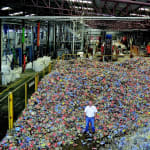
Plastic waste desecrating beaches and rivers or oozing out of the ruptured belly of a dead fish - at the moment, these disturbing images seem to be ubiquitous. Consequently, the image of plastics has never been as negative as it is today, and discussions regarding the use of plastics have rarely been so emotionally charged. However, the fact is that, with perhaps the exception of a few indigenous peoples, not one of the 7.5 billion inhabitants of this planet could live a normal life without plastic, regardless of whether they are conscious of this or not. After all, plastics have for some considerable time now been used in more applications than toys, household appliances and packaging. Plastics also provide important – indeed almost essential - solutions to problems in the transportation and electronics industries and the medical sector. What are the ramifications of the present situation for the plastics industry, and what options does recycling offer today?
The plastics industry is defending itself against accusations, but it must present concepts for the future and demonstrate that plastic and environmental protection are compatible. Issues such as waste collection systems and collection rates, recovery methods, recycling and the circular economy are now more centre stage than ever before. Unsurprising, therefore, that the circular economy is one of the leading issues at this year's international K 2019 trade fair. Visitors to this event will be greeted by a variety of proposals and solutions relating to this “green” topic. The industry has achieved much in recent years, as demonstrated in several examples.
The demand for plastics continues to rise - despite, it would seem, their poor image. In its report "Plastics - The Facts", Plastics Europe pointed out that the production of plastics worldwide was 348 million tonnes in 2017, around 4% higher than in 2016. In Europe, the output of the 28 EU countries plus Norway and Switzerland rose from 60 to 64.4 million tonnes (up 7%). Europe accounts for around a fifth of global production, placing it second among producers, after China (29%) and just ahead of the NAFTA region (18%).
Although a degree of consolidation has led to a reduction in the number of companies in the European plastics industry to around 60,000 since the last K event, figures for those employed in the sector have increased, with 1.5 million working in the plastics industry and generating stable sales of about EUR 350bn in 2017.
Almost 40% of plastics produced, indeed the largest proportion, is sourced by the packaging industry where it provides important protection during transportation and ensures the shelf life of goods, making a substantial contribution to environmental protection in the process. In the packaging industry in particular, plastic is frequently the material of choice when it comes to the resource-efficient provision of products and services. Plastics mainly reduce the consumption of resources in the usage phase, a fact which, according to BLV GmbH (Frankfurt), is frequently overlooked when the question of resource conservation arises solely in relation to the handling of waste.
This is also the case when it comes to the second most important customer for plastics: the construction industry. This sector consumes almost 20% of all plastics. The automotive industry uses around 10% of output, achieving the highest level of growth in a comparison of 2016 and 2017. The advantageous of plastics are particularly evident in the car, given their lightness and adaptability in a variety of applications. Their impact on the reduction of the carbon footprint is decisive.
Marine pollution
A look at different consumer sectors clearly indicates that the usage duration for plastic products differs greatly, and this in turn influences recycling rates and options. However, as Plastics Europe has established in its study, the appreciation that plastics are much too valuable to simply discard them at the end of their service life, has grown in Europe. Recycling of plastic waste increased by almost 80% in the ten years between 2006 and 2016. At 40.9%, plastic packaging now accounts for the majority of recycling, followed by energetic recovery at 38.8%.
The compulsion to act that is born of the public perception of plastic waste has contributed to a range of new laws governing higher recycling rates. Following China's lead, other Southeast Asian countries (and Taiwan in December 2018) have imposed import restrictions on plastic waste. Landfill bans on plastic waste are already in force in ten European countries.
Following its prohibition of plastic bags on 1 January 2019, Italy also imposed a ban on cotton buds made of plastic. Legislation with similar rules has been drafted and should become law throughout the EU in 2021. Criticism is also directed at other disposable plastic items such as cutlery, plates, drinking straws, stirrers and balloon sticks. Together with fishing gear, these account for 70% of the 8 million tonnes of plastic that end up in the oceans every year. The EU Commission has proposed requiring that these objects be manufactured from environmentally friendlier, more perishable materials in future. Disposable beverage cups made of plastic should only be permitted if the lid and seal are permanently attached components.



